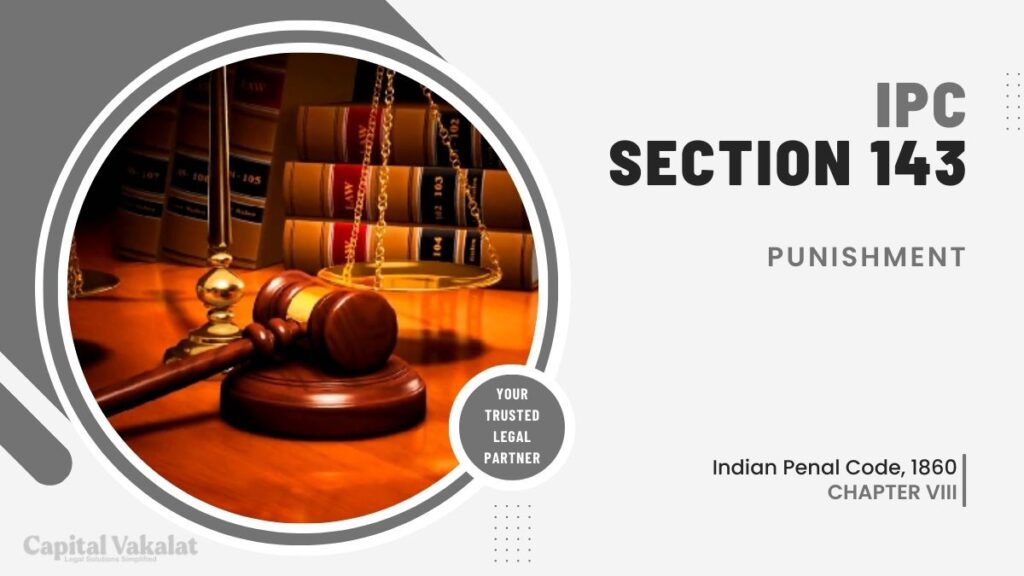Section 143 of the Indian Penal Code (IPC) deals with the offense of unlawful assembly. In this article, we will delve into the intricacies of Section 143 IPC, understanding its historical background, the offenses it covers, legal provisions, real-life applications, and the consequences of violating this section.

Introduction to Section 143 IPC
Section 143 of the IPC defines an unlawful assembly as an assembly of five or more persons who have the common object to commit a crime. The common object can be anything that is illegal or contrary to the law. This section plays a crucial role in maintaining law and order in society.
Historical Perspective
The concept of unlawful assembly traces its roots back to the colonial era when the British introduced this section in the IPC. Its primary purpose was to curb gatherings that could lead to public disorder or pose a threat to the British Raj.
Purpose and Significance
Section 143 IPC serves the vital purpose of preventing and punishing unlawful assemblies, thereby ensuring the security and harmony of society. It empowers law enforcement agencies to take action against individuals or groups engaged in activities detrimental to public peace and order.
Offenses Covered Under Section 143 IPC
Unlawful Assembly
An unlawful assembly is defined as a gathering of five or more individuals with a common object. The mere fact that an assembly is unlawful does not, by itself, constitute an offense. The participants must have a shared criminal intention.
Participation in an Unlawful Assembly
Section 143 IPC extends to those who voluntarily join an unlawful assembly and participate in its activities. This can include acts of violence or aggression.
Rioting
Rioting involves the use of force or violence by an unlawful assembly. It is an offense that often follows unlawful assemblies and can lead to severe consequences.
Punishment for Rioting
Those found guilty of rioting can face harsh penalties, including imprisonment. The severity of the punishment depends on the gravity of the offense.
Legal Provisions and Interpretation
Ingredients for Conviction
For a conviction under Section 143 IPC, the prosecution must establish that there was indeed an unlawful assembly and that the accused were a part of it. Additionally, it must be proven that the assembly had a common object, and the accused shared this intention.
The Role of Common Object
The common object is a key element in determining the guilt of those involved in an unlawful assembly. It signifies the purpose for which the assembly was formed and pursued.
The Act of Affray
Affray is another offense related to unlawful assemblies. It occurs when two or more persons fight in a public place, causing terror to the public. Section 143 IPC can also be invoked in such cases.
Real-life Applications and Case Studies
Notable Cases Under Section 143 IPC
Several high-profile cases in India have utilized Section 143 IPC to prosecute individuals involved in unlawful assemblies. These cases have set legal precedents and underscored the importance of this legal provision.
Legal Defenses
While Section 143 IPC allows for the prosecution of individuals involved in unlawful assemblies, it also provides opportunities for legal defenses. Knowledgeable legal counsel can help accused individuals navigate these defenses.
Consequences and Punishments
Punishment for Violating Section 143 IPC
Those convicted under Section 143 IPC can face imprisonment and fines. The punishment varies depending on the nature and severity of the unlawful assembly and the resultant actions.
Enhancement of Punishment
In certain circumstances, the punishment under Section 143 IPC can be enhanced. This occurs when the unlawful assembly uses firearms or other deadly weapons.
Conclusion
Section 143 of the Indian Penal Code is a crucial legal provision aimed at maintaining public peace and order. It defines unlawful assembly, outlines the associated offenses, and prescribes punishments for those found guilty. Understanding this section is vital for both legal professionals and the general public.
FAQs
How does the court determine the common object of an assembly?
The court determines the common object of an assembly by examining the actions, speeches, and behavior of the participants. It looks for evidence of a shared intention to commit a crime or engage in activities against the law.
What are the key differences between rioting and affray under this section?
Rioting involves the use of force or violence by an unlawful assembly, while affray is a situation where two or more individuals engage in a public fight causing terror. Both are separate offenses, but Section 143 IPC can apply to either situation.
Are there any limitations on invoking Section 143 IPC?
Section 143 IPC can be invoked when there is a genuine case of unlawful assembly with a common object to commit a crime. It should not be misused to suppress peaceful gatherings or free expression of opinion.
What steps can one take if wrongly accused of participating in an unlawful assembly?
If wrongly accused, one should seek legal counsel immediately. A skilled lawyer can help build a strong defense, gather evidence to prove innocence, and ensure a fair legal process is followed. It’s important to act promptly and in consultation with legal experts.